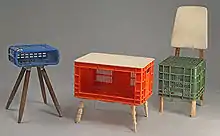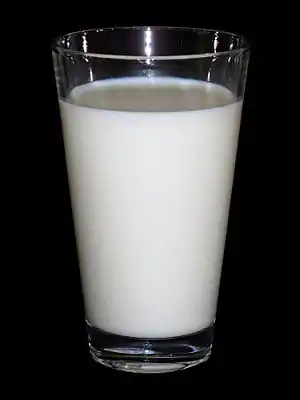Milk crate
Milk crates are square or rectangular interlocking boxes that are used to transport milk and other products from dairies to retail establishments.

In English-speaking parts of Europe the term "bottle crate" is more common but in the United States the term "milk crate" is applied even when the transported beverage is not milk.
History
The dimensions of the milk crate may have been influenced by the dimensions of the tea chest. For all practical purposes, both hold similar internal volumes, but tea chests are designed for shipping over the open ocean.
The bottle crate emerged after the tea chest was a de facto shipping method. The plastic milk crate is claimed as an Australian invention, produced through a period of trial and error in design by the Dairy Farmers Cooperative Milk Company in the 1950s and 60s.[1]
Design
Middle 20th century bottle crates were made of wood, later ones were stainless steel, and those made in the latter part of the century were of heavy-duty polyethylene.
The most common milk crate sizes are designed to carry several 1-US-gallon (3.8 l; 0.83 imp gal) milk jugs:[2]
| Number of jugs carried | Internal dimensions |
|---|---|
| 4 | 12 by 12 inches (300 by 300 mm) |
| 6 | 18.25 by 12 inches (464 by 305 mm) |
Uses and recycling
Milk crates are often stolen for either personal or business use or for the plastic that they are made out of. Theft of milk crates can cost dairies millions of US dollars per year.[3]
This has led at least one dairy farm to hire a private investigator to discover what is happening to the crates;[4] the results of investigations point to plastic re-sellers being the culprits in the majority of thefts.[5]
Alternate shipping methods
In July 2008, Wal-Mart and some other stores introduced a square milk jug that does not need to be transported in a crate. Sometimes called "green" milk jugs, they are not green in color, but rather are claimed to be environmentally friendly.
These new milk jugs are stackable, and can be transported without crates. Companies need not buy plastic for the crates, nor transport or wash them.[6]
See also
References
- Meares, Joel (3 August 2014). "A tall order for the humble milk crate amuses its inventor". The Sydney Morning Herald. Retrieved 16 January 2019.
- "About Farmplast". Milkcratesdirect.com. Retrieved 16 January 2019.
- Brat, Ilan (June 6, 2006). "Police ask: got milk crates?". Pittsburgh Post-Gazette. The Wall Street Journal. Retrieved 30 December 2018.
- Loepp, Don (July 2007). "Milk Crate Bandits". Plastics News. Archived from the original on 2008-10-30. Retrieved 2009-05-07.
- "Los Angeles County Crate Theft". April 2008, Los Angeles County Solid Waste Management Committee / Integrated Waste Management Task Force. L.A. Department of Public Works.
- "Cheaper, Stackable, "Green" Milk Jugs Cause a Stir" Archived 2009-01-07 at the Wayback Machine. Jason Mick (Blog), July 1, 2008, DailyTech.com.

